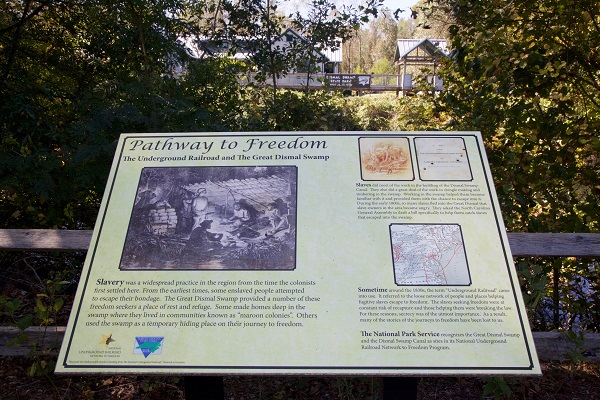
The Underground Railroad was at its height between 1810 and 1850 with over 30,000 people escaping enslavement, mainly to Canada, via the network. The U.S. Census figures only account for 6,000. The Great Dismal Swamp was a known route for runaway slaves. This route was the most rugged and treacherous route where insects, snakes and wild animals were abundant. Moses Grandy, a slave, was born in Camden County in 1786. Moses tried three times to buy his freedom. He was an industrious man who worked hard and was respected by all, even those who had taken his money and denied his freedom.
In the nineteenth century, the Great Dismal Swamp was a morass of huge trees towering over dense underbrush and delicate ferns, inhabited by black bears, wildcats, wild cattle, hogs, and poisonous snakes. It was to this inhospitable place many slaves came. The foreboding swamp provided a natural refuge for runaways. Following the American Revolution, there were numerous instances of slave resistance. While some runaways were able to blend in with free blacks, many chose to seek refuge among a colony of runaways (called maroons) in the Great Dismal Swamp. The very nature of the swamp made it possible for a large colony to establish a permanent refuge. It was difficult to capture a slave once they reached the swamp although occasional forays were made into the swamp to recapture runaways with specially trained dogs.

Colonies were established on high ground in the swamp where slaves build crude huts. Family life evolved, and the abundant animal life provided food and clothing. Some earned money by working for free black shingle makers, who hired the maroons to cut logs, playing them with small amounts of food, money or precious clothing. Sometimes runaways were betrayed by the Negro lumbermen. Renegade fugitives often raided nearby towns or preyed upon travelers along the stage road. Others stole from boats anchored along the canal. These violent rebels were a dreaded menace to the whole swamp community. Slave disturbances in the early 1800's caused much alarm among residents living near the swamp. Tidewater Virginia residents were greatly concerned about reported unrest among slaves in nearby Camden, Elizabeth City and Currituck County, North Carolina. In the spring of 1823, the situation was so serious a large militia force with dogs was sent to wipe out the colony of slaves in the swamp. Even though some were captured or killed, most of the maroons escaped. A brutal slave uprising in 1831 resulted in the butchering of 13 men, 18 women, and 24 children in Courtland, Virginia. Following the Southampton County slave rebellion, it was feared that many of the insurgents planned to flee to the swamp. The leader of the rebellion was Nat Turner, a powerful Baptist preacher with a large loyal following, who remained at large for several months, causing speculation he was hiding in the swamp. Expeditions searched for him, capturing a number of maroons. Nat Turner was eventually caught. While returning from a trip to England in 1842 Henry Wadsworth Longfellow composed his poem "THE SLAVE IN DISMAL SWAMP", telling of the miserable plight of a Negro in hiding. In 1856, David Strother wrote a description of the swamp's beauty and fearsome natives for Harper's magazine. As an artist, he sketched the legendary Osman, who, according to legend, protected the Negro slave Escapees. Harriet Beecher Stowe used this sketch by Strother as the main character in her novel, DRED: A TALE OF THE GREAT DISMAL SWAMP.
For more information about African American Heritage in Camden County, visit the Camden County Heritage Museum, Dismal Swamp State Park, Dismal Swamp Welcome Center.
Click here to download the African American Heritage Brochure.
